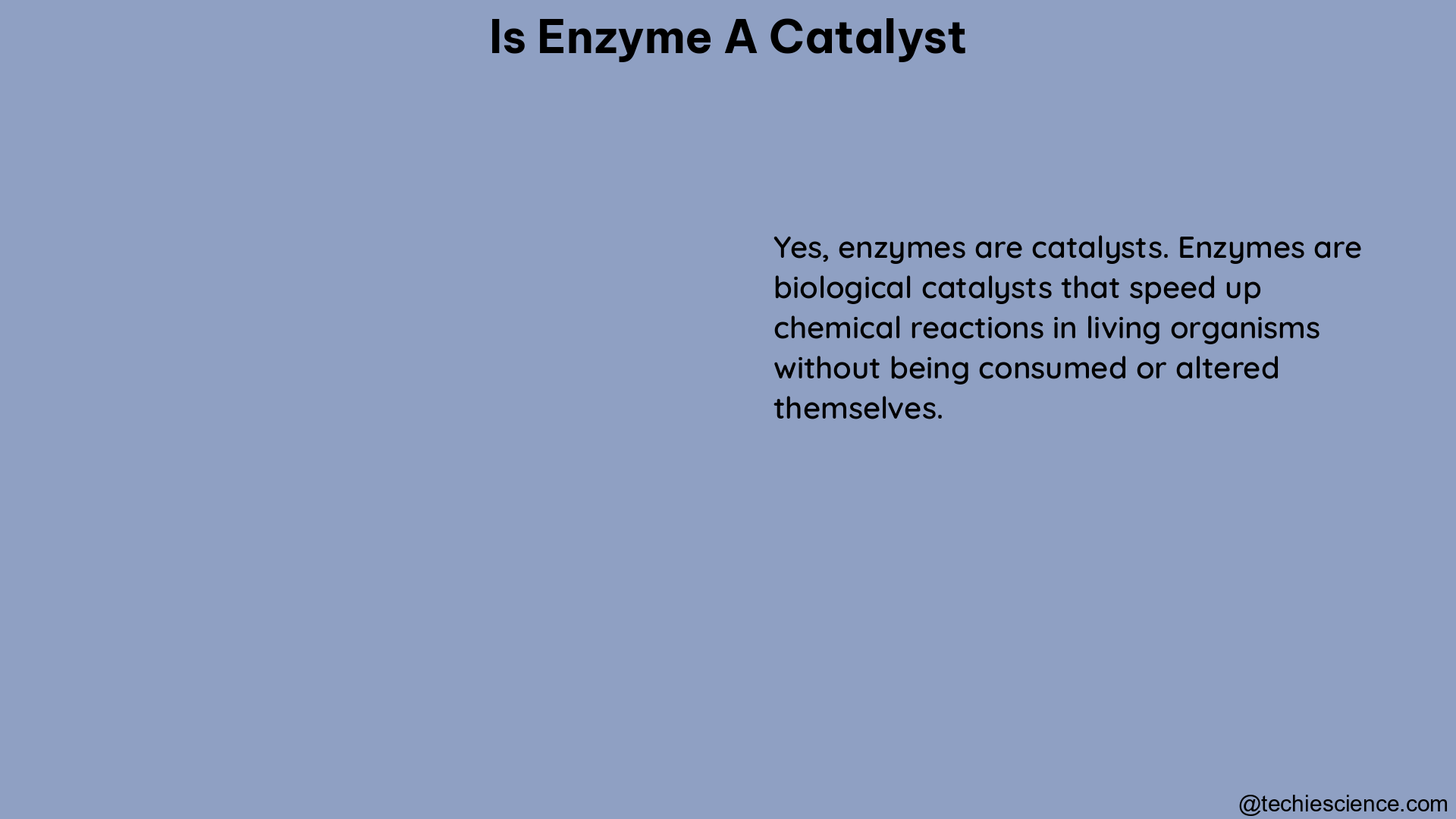Enzymes are indeed catalysts, and they play a crucial role in speeding up biochemical reactions in living organisms. They are known as biological catalysts or biocatalysts, capable of increasing reaction rates by a factor of 10^8 to 10^17, which is an extraordinary enhancement.
Understanding Enzyme Catalysis
Enzyme Kinetics and the Michaelis-Menten Equation
Enzyme kinetics is the study of factors that determine the speed of enzyme-catalyzed reactions. Enzyme kinetics experiments typically involve measuring the rate of product formation or substrate consumption over time, under controlled conditions of temperature, pH, and enzyme and substrate concentrations. The Michaelis-Menten equation is a fundamental tool in enzyme kinetics, describing the relationship between the initial rate of reaction and the substrate concentration.
The Michaelis-Menten equation is expressed as:
v = (Vmax * [S]) / (Km + [S])
Where:
– v is the initial rate of the reaction
– Vmax is the maximum rate of the reaction
– [S] is the substrate concentration
– Km is the Michaelis constant, which represents the substrate concentration at which the reaction rate is half of Vmax
By analyzing the kinetic parameters Vmax and Km, researchers can gain insights into the catalytic efficiency and substrate affinity of an enzyme.
Catalytic Efficiency and the kcat Value
The enormous catalytic activity of enzymes can be expressed by a constant, kcat, which is a measure of the number of substrate molecules converted to product per unit time per enzyme molecule. The kcat value varies widely among different enzymes, reflecting their specific catalytic efficiencies.
For example, the kcat value for carbonic anhydrase, an enzyme that catalyzes the conversion of carbon dioxide to bicarbonate, is around 10^6 s^-1, while the kcat value for triosephosphate isomerase, an enzyme involved in glycolysis, is around 10^3 s^-1.
Enzyme Structure and Specificity
The chemical structure of an enzyme is closely related to its specificity and catalytic activity. Enzymes are typically globular proteins, with a characteristic three-dimensional structure that creates a unique active site where the substrate binds and the reaction takes place.
The active site of an enzyme is highly specific, recognizing and binding only a particular substrate or a narrow range of substrates. The binding of the substrate to the active site induces a conformational change in the enzyme, bringing the catalytic groups into proximity and aligning them for optimal interaction with the substrate.
This specificity is achieved through the precise arrangement of amino acid residues within the active site, which create a complementary shape and chemical environment for the substrate. The active site may also contain cofactors, such as metal ions or organic molecules, that further enhance the catalytic activity of the enzyme.
Regulation of Enzyme Activity

Enzymes can be regulated by various mechanisms, including allosteric regulation, covalent modification, and proteolytic cleavage.
Allosteric Regulation
Allosteric regulation involves the binding of a regulatory molecule to a separate site on the enzyme, called the allosteric site, which changes the conformation of the enzyme and affects its activity. This can either increase or decrease the enzyme’s catalytic efficiency, depending on the nature of the regulatory molecule and the specific enzyme.
Covalent Modification
Covalent modification involves the addition or removal of a chemical group to or from the enzyme, altering its activity. This can be achieved through the action of other enzymes, such as kinases or phosphatases, which add or remove phosphate groups, respectively.
Proteolytic Cleavage
Proteolytic cleavage involves the cleavage of the enzyme by a protease, resulting in the activation or inactivation of the enzyme. This mechanism is often used to regulate the activity of enzymes involved in cascading signaling pathways, such as the blood clotting cascade.
Conclusion
In summary, enzymes are potent catalysts that play a crucial role in speeding up biochemical reactions in living organisms. They are highly specific, with a characteristic three-dimensional structure that creates a unique active site where the substrate binds and the reaction takes place. The chemical structure of an enzyme is closely related to its specificity and catalytic activity, and enzymes can be regulated by various mechanisms, including allosteric regulation, covalent modification, and proteolytic cleavage. The enormous catalytic activity of enzymes can be expressed by a constant, kcat, which is a measure of the number of substrate molecules converted to product per unit time per enzyme molecule.
References:
– Enzymes: principles and biotechnological applications – PMC – NCBI. https://www.ncbi.nlm.nih.gov/pmc/articles/PMC4692135/
– Enzymes are biological catalysts. A. Relate the chemical structure of an enzyme to its specificity and catalytic activity. B. Design a quantitative experiment to investigate the influence of pH or temperature on the activity of an enzyme. C. Describe what information can be obtained from enzyme kinetics experiments. https://homework.study.com/explanation/enzymes-are-biological-catalysts-a-relate-the-chemical-structure-of-an-enzyme-to-its-specificity-and-catalytic-activity-b-design-a-quantitative-experiment-to-investigate-the-influence-of-ph-or-on-the-activity-of-an-enzyme-c-describe-what-information.html
– Enzyme Catalyst – an overview | ScienceDirect Topics. https://www.sciencedirect.com/topics/chemistry/enzyme-catalyst

Hi, I am Saif Ali. I obtained my Master’s degree in Microbiology and have one year of research experience in water microbiology from National Institute of Hydrology, Roorkee. Antibiotic resistant microorganisms and soil bacteria, particularly PGPR, are my areas of interest and expertise. Currently, I’m focused on developing antibiotic alternatives. I’m always trying to discover new things from my surroundings. My goal is to provide readers with easy-to-understand microbiology articles.
If you have a bug, treat it with caution and avoid using antibiotics to combat SUPERBUGS.
Let’s connect via LinkedIn: